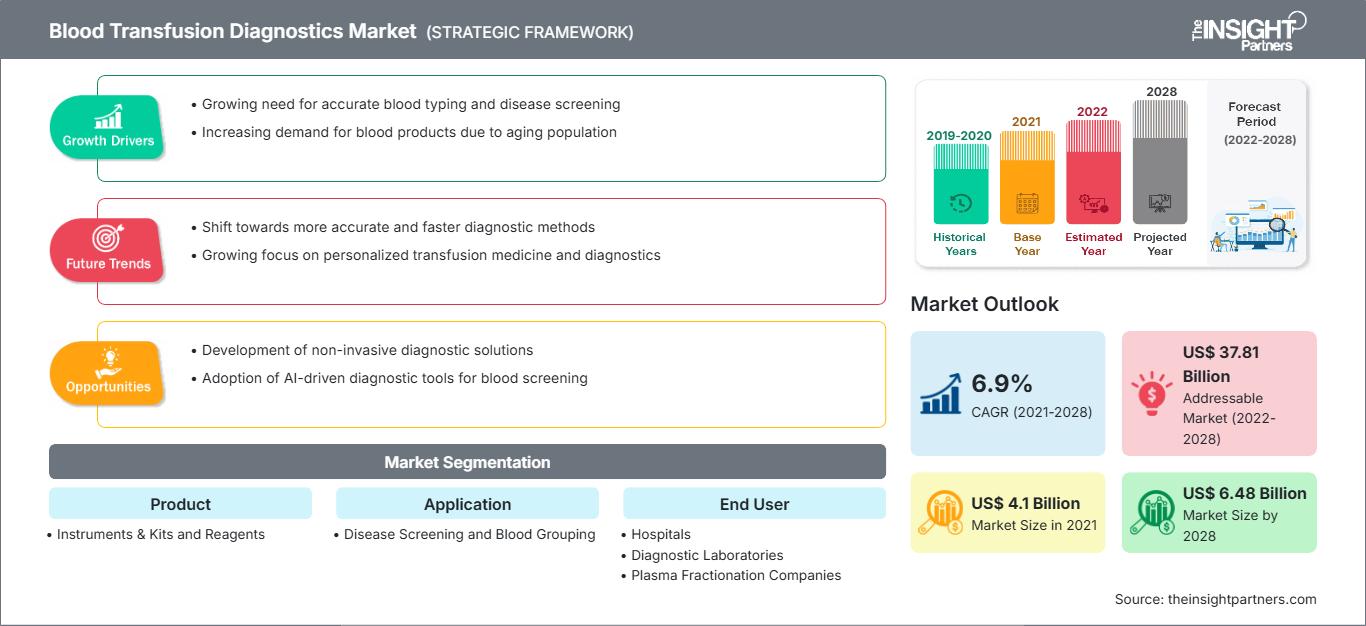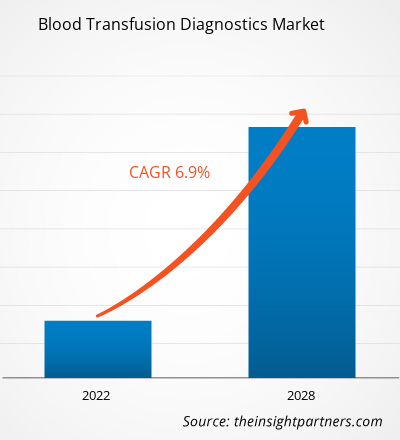[研究报告]预计输血诊断市场规模将从2021年的40.9693亿美元增长到2028年的64.8375亿美元。预计2022年至2028年的复合年增长率为6.9%。
输血诊断是在血液输给患者之前进行的检测。输血是一种常见的程序,将捐献的血液或其成分通过静脉途径输入患者体内。每单位血液都必须进行血型鉴定,即血型识别和血液筛查,包括疾病检测测试,以避免副作用或感染传播。
本报告对全球输血诊断市场进行了深入的分析和洞察,重点关注各种参数,包括市场趋势、技术进步、市场动态以及全球主要市场参与者的竞争格局分析。它还包括 COVID-19 大流行对所有地区市场的影响。COVID-19 大流行对全球输血诊断市场的增长产生了负面影响。由于政府实施的严格限制导致外科手术数量减少,该公司的收入大幅下降。这些服务主要用于失血量大的手术,例如骨科和心脏手术。由于手术数量减少,输血需求也减少了。例如:根据美国医学会发布的数据,估计由于 COVID-19 大流行,美国外科手术总数减少了 48%。然而,在大流行限制恢复正常后,外科手术量恢复到正常水平。
自定义此报告以满足您的要求
您将免费获得任何报告的定制,包括本报告的部分内容,或国家级分析、Excel 数据包,以及为初创企业和大学提供超值优惠和折扣
输血诊断市场: 战略洞察

-
获取本报告的主要市场趋势。这个免费样本将包括数据分析,从市场趋势到估计和预测。
基于地理的洞察
按地域划分,全球输血诊断市场分为北美(美国、加拿大和墨西哥)、欧洲(法国、德国、英国、西班牙、意大利和欧洲其他地区)、亚太地区(中国、印度、日本、澳大利亚、韩国和亚太地区其他地区)、中东和非洲(沙特阿拉伯、阿联酋、南非和中东和非洲其他地区)以及南美洲和中美洲(巴西、阿根廷和南美洲和中美洲其他地区)。
市场洞察
器官移植手术增加导致输血需求
器官移植是在器官衰竭的情况下进行的外科手术。由于慢性肾病 (CKD)、多囊肾病、囊性纤维化和先天性心脏病等需要移植的慢性疾病病例不断增加,器官移植手术通常针对心脏、肝脏、肾脏和其他各种器官。这些手术通常需要数小时,而且会大量失血,需要输血。例如,根据器官共享联合网络 (UNOS) 的数据,美国进行的器官移植数量持续增长,2021 年进行了超过 41,000 例移植手术。同样,根据世界移植登记处的数据,西班牙在 2019 年占欧洲所有器官捐赠的 20%,占全球的 6%。澳大利亚的器官捐献率近期有所提高,2019年升至每百万人口21.8人。
同样,加拿大每百万人口有22.2人捐献,并且还在稳步提高,这部分归功于“捐献医生”的数据——负责器官捐献的重症监护医生。根据世界移植登记处的数据,中国2019年有5818人捐献,即每百万人口4.1人;印度2019年有715人捐献,即每百万人口0.5人。另一方面,俄罗斯的器官捐献率略高,为每百万人口5.1人。公私合作伙伴关系与移植协调员合作,显著促进了需要持续输血的器官移植的改善。发展中国家和发达国家的器官移植手术数量均有所增加。例如,印度和新加坡等发展中国家正在成为亚太地区的医疗旅游目的地。各国在提供更好、更先进的医疗服务方面正在不断进步。器官移植需求的不断增长是推动全球输血诊断需求的关键因素之一。
基于产品的洞察
根据产品,全球输血诊断市场分为仪器和试剂盒以及试剂。2021 年,仪器和试剂盒占据了更大的市场份额。预计该细分市场在 2022 年至 2028 年期间的复合年增长率将更高。
基于应用的洞察
根据应用,全球输血诊断市场分为疾病筛查和血型分析。疾病筛查细分市场在 2021 年占据了更大的市场份额,预计在预测期内将实现更高的复合年增长率。
输血诊断市场区域洞察
The Insight Partners 的分析师已详尽阐述了预测期内输血诊断市场的区域趋势和影响因素。本节还讨论了北美、欧洲、亚太地区、中东和非洲以及南美和中美洲的输血诊断市场细分和地域分布。
输血诊断市场报告范围
| 报告属性 | 细节 |
|---|---|
| 市场规模 2021 | US$ 4.1 Billion |
| 市场规模 2028 | US$ 6.48 Billion |
| 全球复合年增长率 (2021 - 2028) | 6.9% |
| 历史数据 | 2019-2020 |
| 预测期 | 2022-2028 |
| 涵盖的领域 |
By 产品
|
| 覆盖地区和国家 |
北美
|
| 市场领导者和主要公司简介 |
|
输血诊断市场参与者密度:了解其对业务动态的影响
输血诊断市场正在快速增长,这得益于终端用户需求的不断增长,而这些需求的驱动因素包括消费者偏好的演变、技术进步以及对产品优势的认知度不断提高。随着需求的增长,企业正在扩展产品线,不断创新以满足消费者需求,并抓住新兴趋势,从而进一步推动市场增长。

- 获取 输血诊断市场 主要参与者概述
基于最终用户的洞察
根据最终用户,全球输血诊断市场细分为血库、医院、诊断实验室和血浆分离公司。血库细分市场在2021年占据了最大的市场份额。预计该细分市场将在2022年至2028年期间实现最高的复合年增长率。
全球输血诊断市场参与者采取有机战略,包括产品发布和扩张,以扩大其全球业务范围和产品组合,并满足不断增长的需求。市场的主要参与者包括Grifols, SA;F. Hoffmann-La Roche Ltd;Immucor, Inc.;Bio-Rad Laboratories, Inc.;Abbott;Thermo Fisher Scientific Inc.;Ortho Clinical Diagnostics;DiaSorin SpA;Quotient Limited;以及BAG Diagnostics GmbH。
- 历史分析(2 年)、基准年、预测(7 年)及复合年增长率
- PEST和SWOT分析
- 市场规模、价值/数量 - 全球、区域、国家
- 行业和竞争格局
- Excel 数据集
近期报告
相关报告
客户评价
购买理由
- 明智的决策
- 了解市场动态
- 竞争分析
- 客户洞察
- 市场预测
- 风险规避
- 战略规划
- 投资论证
- 识别新兴市场
- 优化营销策略
- 提升运营效率
- 顺应监管趋势






















 获取免费样品 - 输血诊断市场
获取免费样品 - 输血诊断市场